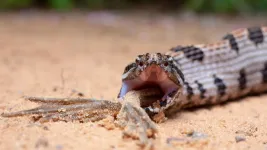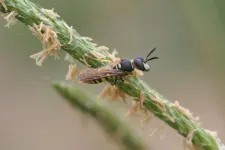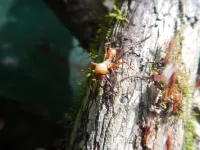B cell activating factor possible key to hemophilia immune tolerance
2021-04-19
(Press-News.org) A group of scientists have just made a key discovery that could prevent and eradicate immune responses that lead to treatment failure in about one-third of people with severe hemophilia A.
Hemophilia is the most common severe inherited bleeding disorder in men. The disease affects 1 in 10,000 males worldwide and results from deficiency of blood clotting factor VIII (FVIII). Both children and adults with hemophilia A (80 percent of all hemophilia) receive treatment that involves infusing FVIII protein into the bloodstream. However, about 30 percent of them develop an immune response in the form of antibodies to FVIII (inhibitors), rendering treatment ineffective and increasing risk of mortality.
For inhibitor-positive patients, immune tolerance induction (ITI) options are scarce, costly and invasive. Investigators at Indiana University School of Medicine, Children's Hospital of Philadelphia and University of Pennsylvania joined efforts to explore immune responses to FVIII under an NIH-funded U54 initiative.
The study, led by IU School of Medicine's Moanaro Biswas, PhD, and Valder R. Arruda, MD, PhD, from Children's Hospital of Philadelphia and the University of Pennsylvania, is titled "B cell activating factor modulates the factor VIII immune response in hemophilia," and was published in the Journal of Clinical Investigation earlier this month. Bhavya Doshi, MD, from Children's Hospital of Philadelphia, as is the first author.
In it, the group used plasma samples from pediatric and adult hemophilia A patients and animal models to determine whether BAFF plays a role in the generation and maintenance of FVIII inhibitors.
They also looked at combining antibody to BAFF in an ITI approach with a CD20 antibody (rituximab). Rituximab alone has shown mixed results in eradicating inhibitors when used alone in previous studies for hemophilia A.
Major findings from the study include:
BAFF levels in plasma are higher in both pediatric and adult hemophilia A patients with persistent FVIII inhibitors, and correlate with FVIII antibody titers, suggesting that BAFF could be a potential harbinger for an ongoing humoral immune response to FVIII
An increase in BAFF levels after rituximab-based therapy precludes tolerance to FVIII.
Blocking BAFF is effective in the prevention of FVIII inhibitors in an animal model of hemophilia A.
Combination CD20/BAFF monoclonal antibody therapy induces tolerance in a hemophilia A animal model with established FVIII inhibitors. This is due to a concerted effect of the combination therapy on memory B cells and plasma cells.
Next, the group will perform in-depth mechanistic studies to identify additional BAFF modifiers, which may provide additional insight into the pathways that lead to BAFF elevation and inhibitor formation.
These data also have important translational potential for inhibitor in hemophilia A, since there is an FDA-approved anti-BAFF antibody currently used as part of immunosuppressive regimens for autoimmune diseases.
INFORMATION:
Study co-authors are Jyoti Rana, PhD; Giancarlo Castaman, MD, PhD; Mostafa A. Shaheen, BA; Radoslaw Kaczmarek, PhD; John S. Butterfield, BS; Shannon L. Meeks, MD; and Cindy Leissinger, MD.
The study includes contributions from the Herman B Wells Center for Pediatric Research, IU School of Medicine; Perelman School of Medicine, University of Pennsylvania; Center for Bleeding Disorders and Coagulation, Careggi University Hospital; Aflac Cancer Center and Blood Disorders Center at Children's Healthcare of Atlanta, Emory School of Medicine; Tulane University School of Medicine and Children's Hospital of Philadelphia.
ELSE PRESS RELEASES FROM THIS DATE:
2021-04-19
Our planet's worst mass extinction event happened 252 million years ago when massive volcanic eruptions caused catastrophic climate change. The vast majority of animal species went extinct, and when the dust settled, the planet entered the early days of the Age of Dinosaurs. Scientists are still learning about the patterns of which animals went extinct and which ones survived, and why. In a new study in PNAS, researchers found that while extinctions happened rapidly in the oceans, life on land underwent a longer, more drawn-out period of extinctions.
"People assumed that because the marine extinction happened over a short period of time, life on land should have followed the same pattern, but we found that the marine extinction ...
2021-04-19
Professor Nicole Boivin, Director of the Department of Archaeology at the Max Planck Institute for the Science of Human History in Jena, Germany, is part of an international initiative to examine the implications of past land use for contemporary conservation efforts.
The multi-disciplinary team, which includes archaeologists, ecologists, anthropologists and conservation managers, has reconstructed ancient population and land use to show that already by 12,000 years ago, humans had re-shaped much of the terrestrial biosphere.
Their data challenge the idea that conservation ...
2021-04-19
New research published today in the Proceedings of the National Academy of Sciences (PNAS) shows that land use by human societies has reshaped ecology across most of Earth's land for at least 12,000 years. The research team, from over ten institutions around the world, revealed that the main cause of the current biodiversity crisis is not human destruction of uninhabited wildlands, but rather the appropriation, colonization, and intensified use of lands previously managed sustainably.
The new data overturn earlier reconstructions of global land use history, some of which indicated that most of Earth's land was uninhabited even as recently as 1500 CE. Further, ...
2021-04-19
Diversity in diet plays a role in the complexity of venom in pit vipers such as rattlesnakes, copperheads and cottonmouths.
But new collaborative research by Clemson University scientists found the number of prey species a snake ate did not drive venom complexity. Rather, it was how far apart the prey species were from each other evolutionarily.
"It's not just diet that drives the variation in venom across snakes. It's the breadth of diet," said Christopher Parkinson, a professor in the College of Science's Department of Biological Sciences. "If a snake eats 20 different species of mammals, its venom will not be very complex. But if it eats a centipede, a frog, a bird and a mammal, it's going to have a highly complex venom because each component of that venom ...
2021-04-19
Antibiotics on the cocoon protect the offspring of beewolves, a group of digger wasps, from detrimental fungi. These protective substances are produced by symbiotic bacteria of the genus Streptomyces, which live in these insects. In a new study in PNAS, researchers from the Max Planck Institute for Chemical Ecology and the University of Mainz, together with an international team, showed that these beneficial bacteria are losing genetic material that is no longer needed. The genome of these bacteria is of great interest for understanding the process of genome erosion and elucidating how the cooperation and the mutual benefit between bacteria and their host insects have evolved over long periods of time (PNAS, doi: 10.1073/pnas.2023047118, ...
2021-04-19
Police violence against Black Americans is shamefully common in the United States and devastates communities. For incidents that get widespread media exposure, a collective trauma is felt across the nation, especially for Black individuals. Research supports that experiencing racism even vicariously can harm the mental and physical health of others of the same racial group, yet its effect on a population level is unclear.
A new study analyzed how highly publicized acts of racial violence impacted the mental health of Black Americans in the U.S. The authors identified 49 incidents that occurred between 2013 and 2017, including police killings of Black individuals, hate-crime murders and decisions not to indict or convict the officers involved. The researchers measured ...
2021-04-19
What keeps some plants squatting close to the soil while others - even those closely related - reach high for the skies?
New research addressing the architecture and growth habit of plants has provided an answer to this question and may assist in the development of better performing crops.
The way plants grow must sometimes satisfy contradictory needs. Growing close to the ground, decreases the chances of being grazed, but this presents the need to rise rapidly to allow seeds to disperse. This can be observed in dandelions and in Arabidopsis, a model species commonly used to study plant development.
Agriculture has taken advantage of the diversification of growth habit so that ...
2021-04-19
Like superheroes capable of seeing through obstacles, environmental regulators may soon wield the power of all-seeing eyes that can identify violators anywhere at any time, according to a new Stanford University-led study. The paper, published the week of April 19 in Proceedings of the National Academy of Sciences (PNAS), demonstrates how artificial intelligence combined with satellite imagery can provide a low-cost, scalable method for locating and monitoring otherwise hard-to-regulate industries.
(WATCH VIDEO: https://www.youtube.com/watch?v=LHvRgKmJOK8)
"Brick kilns have proliferated across Bangladesh to supply the growing economy with construction materials, which makes it really hard for regulators to keep up with new kilns that are constructed," ...
2021-04-19
A new type of collective behaviour in ants has been revealed by an international team of scientists, headed by biologist Professor Iain Couzin, co-director of the Cluster of Excellence "Centre for the Advanced Study of Collective Behaviour" at the University of Konstanz and director at the co-located Max Planck Institute of Animal Behavior, and Matthew Lutz, a postdoctoral researcher in Couzin's lab. Their research shows how ants use self-organized architectural structures called "scaffolds" to ensure traffic flow on sloped surfaces. Scaffold formation results from individual sensing and decision-making, ...
2021-04-19
Researchers at Baylor College of Medicine and collaborators at other institutions have discovered that POT1, a gene known to be associated with risk of glioma, the most common type of malignant brain tumor, mediates its effects in a sex-specific manner. Researchers found that female mice with glioma that lacked the gene survived less than males. This led them to investigate human glioma cells, where they found that low POT1 expression correlated with reduced survival in females.
Published in the journal Cancer Research, the study also shows that, compared to males', female tumors had reduced expression of immune signatures and increased expression of cell replication markers, suggesting that the immune response and tumor cell proliferation seemed to be ...
LAST 30 PRESS RELEASES:
[Press-News.org] B cell activating factor possible key to hemophilia immune tolerance






